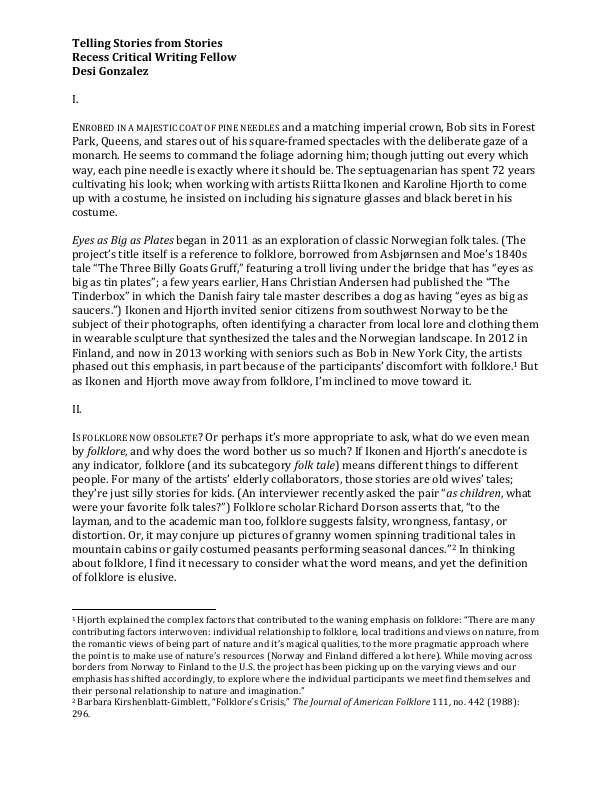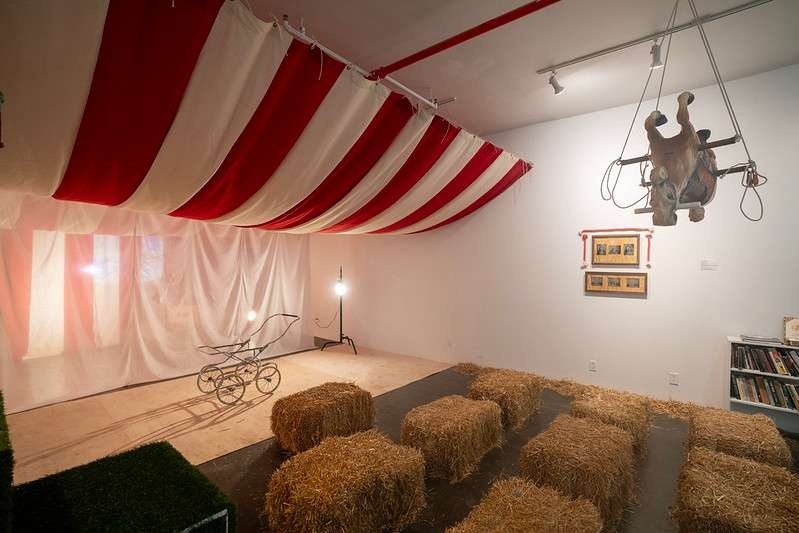I.
Enrobed in a majestic coat of pine needles and a matching imperial crown, Bob sits in Forest Park, Queens, and stares out of his square-framed spectacles with the deliberate gaze of a monarch. He seems to command the foliage adorning him; though jutting out every which way, each pine needle is exactly where it should be. The septuagenarian has spent 72 years cultivating his look; when working with artists Riitta Ikonen and Karoline Hjorth to come up with a costume, he insisted on including his signature glasses and black beret in his costume.
Eyes as Big as Plates began in 2011 as an exploration of classic Norwegian folk tales. (The project’s title itself is a reference to folklore, borrowed from Asbjørnsen and Moe’s 1840s tale “The Three Billy Goats Gruff,” featuring a troll living under the bridge that has “eyes as big as tin plates”; a few years earlier, Hans Christian Andersen had published the “The Tinderbox” in which the Danish fairy tale master describes a dog as having “eyes as big as saucers.”) Ikonen and Hjorth invited senior citizens from southwest Norway to be the subject of their photographs, often identifying a character from local lore and clothing them in wearable sculpture that synthesized the tales and the Norwegian landscape. In 2012 in Finland, and now in 2013 working with seniors such as Bob in New York City, the artists phased out this emphasis, in part because of the participants’ discomfort with folklore.[1] But as Ikonen and Hjorth move away from folklore, I’m inclined to move toward it.
II.
Is folklore now obsolete? Or perhaps it’s more appropriate to ask, what do we even mean by folklore, and why does the word bother us so much? If Ikonen and Hjorth’s anecdote is any indicator, folklore (and its subcategory folk tale) means different things to different people. For many of the artists’ elderly collaborators, those stories are old wives’ tales; they’re just silly stories for kids. (An interviewer recently asked the pair “as children, what were your favorite folk tales?”) Folklore scholar Richard Dorson asserts that, “to the layman, and to the academic man too, folklore suggests falsity, wrongness, fantasy, or distortion. Or, it may conjure up pictures of granny women spinning traditional tales in mountain cabins or gaily costumed peasants performing seasonal dances.”[2] In thinking about folklore, I find it necessary to consider what the word means, and yet the definition of folklore is elusive.
Folklore today has a broad scope, loosely defined as all of the aspects of collective identity that are transmitted informally within a particular community, such as stories, music, jokes, and visual art, and encompassing both the past and present. Folklore scholar Jeannie B. Thomas describes any number of everyday actions that could fall under this purview: “a teenager tells another friend about the sighting of a ghostly light in the nearby woods, a co-worker shares the latest political joke, a parent teaches a child to tie her shoes, a singer learns a song from friends around a kitchen table.”[3] This perspective is rather expansive; under such broad criteria, what isn’t folklore? Some scholars contend that the defining characteristic of folklore is oral tradition, that is, those elements of culture which are disseminated informally by word of mouth. Today, the concept of oral tradition is thorny; with the advent of the Internet, Facebook posts and Gchat conversations have replaced mead halls and campfires; “word of mouth” occurs without having to ever utter a syllable. I think Allison Weisberg, in a recent email conversation, put it best: folklore is “telling stories based on stories.” And this brilliantly vague definition is how I’ve chosen to consider it.
III.
Folklore is made, not found. What I mean by this is not that folklore is fictitious, but rather, it is not folklore until named so, and often, moreover, when named by an outsider. Performance scholar Kirshenblatt-Gimblett explains that the Hasidim whom she has studied have been offended by the idea that she considers their Purim plays folklore: “A second life as folklore is just not as good, from their perspective, as a first life of faith.”[4] Here, the mere identification that something is folklore sets up a power dynamic; “we”—that is, scholars and anyone else identifying folklore—“like to think that the ‘real’ folk never refer to what they”—the folk, the provincial, the country bumpkin—“do as folklore.”[5] In 1978 William P. Murphy, explaining why anthropologist Melville Herskovits rejected the term, wrote: “The word had pejorative connotations which offended Africans…It sets up derogatory distinctions between oral and written forms of literature: calling the former folklore invokes connotations of something simple, crude, and less ‘civilized.’”[6]
While these examples of the power dynamics that folklore can engender were presumably unintended, folklore has also been exploited for darker political motives. In Germany in the 1930s, the Nazis supported the formation of the Reich Institute for German Folklore, co-opting folk tales to promote their ideology of Aryan supremacy.[7] In Stalinist Russia, the government similarly handpicked and published traditional tales that promoted Communism’s values.
The United States has its own complicated relationship with folklore. In schools, we teach children Native American legends and tall tales of the Western frontier, without stopping to question the implications of these stories. Native American folklore is shared in an effort to teach students about the original inhabitants of North America. But it’s a slippery slope between celebrating and essentializing a marginalized culture’s folklore. From the arrival of colonists until very recently, Native Americans have been pushed aside, erased, or forced to assimilate to the European colonizers, and yet these stories were appropriated by the colonizers and shared to future generations in a manner that often erases individual tribes into a single, unified entity.
Chelsea Vowel, a Métis from Alberta now living in Montreal, wrote on her blog âpihtawikosisân about the Cherokee-attributed legend of the two wolves. According to the tale, two wolves reside inside of every person, an evil one and a good one; as the old Cherokee explain, it is “the one you feed” that will triumph. It turns out, however, that this story was adapted from an evangelical Christian minister’s writings, an example of how non-natives confuse and replace Native American beliefs with non-native ideals, in effect “silenc[ing] the real voices of native peoples by presenting listeners and readers with something safe and familiar.”[8] In a similar vein, Americans have mythologized the story of Thanksgiving, presenting the holiday as a celebration of the cooperation between Native Americans and Pilgrims while ignoring the bloodshed and famine that the colonizers caused to the natives. The tall tales of the young U.S. expanding westward in the 1800s are meant to instill so-called American values of individualism, prosperity, and freedom. The stories present a motley cast of characters such as Johnny Appleseed, Paul Bunyan, and Pecos Bill, all of who embody and glorify the Manifest Destiny attitude that it is our god-given right to conquer the continent. And in a country made up of immigrants, with much of the population stemming from neither Native Americans nor the pioneers, it is difficult to feel much of an allegiance to any one kind of folklore.
But of course, not all uses of folklore are negative; like language or art or philosophy, folklore is used and shaped by humans, and therefore can be celebrated or exploited. Folklore—those stories told from other stories—exists and has continued to persist because it fulfills vital societal needs; we tell these stories to unite our community, to pass down our values, to reveal something about ourselves.
IV. Swathed in browned pine needles, Bob is transformed into the reigning spirit of Forest Park. He is like the tall tale hero Paul Bunyan and his companion Babe the Blue Ox: based on a true story, but now larger than life.
If folklore is stories told from stories, then folklore undoubtedly exists today; we are just calling it something different. Folklore takes many names: urban legends, memes, gossip, ghost stories. And the vehicles for transmitting today’s lore are more diverse than ever. To be sure, we still learn stories from older generations; we still read fairy tales in children’s books. But today, we disseminate contemporary folklore through tools such as instant messaging, Reddit threads, and email forwards.
Perhaps we don’t recognize contemporary folklore because these narratives are so pervasive. We watch local news reports of mothers suddenly endowed with superhuman strength to lift a bus off the body of their trapped children. New Yorkers have all heard murmurs about the mole people, homeless individuals who took shelter in abandoned underground tunnels and ostensibly established an elaborate tribe-like society under the city’s sidewalks. And children tell each other gruesome yarns, like the one of the girl who decides to put her recently-bathed hamster in the microwave to speed up the drying process, only to have it explode. We all know the stories by heart; we all swear we know someone who knows someone who played a part in the tale.
There’s one particular urban legend that has been told to me by several parties, none of whom have met the other, and yet each time the storyline and rhetorical devices remain unchanged. It goes something like this:
I have a friend who taught at a school in [blank]. A few days before the start of the new school year, he looked at the roster and noticed an unfamiliar: “Le-a.” Wanting to avoid the embarrassment of mispronouncing the student’s name of the first day of school, he called up her mother. “Hi, I’ve never seen such a name before. Is it pronounced Leah? Leia?” In response she erupts: “It’s pronounced ‘Ledasha.’ The dash ain’t silent!”
This story shares many characteristics of traditional folklore: it is transmitted by word of mouth, it is meant to amuse or entertain, it reflects social conventions, and it is plausible but unverified (Snopes.com lists its credibility status as “unknown”). And like some folklore, this urban legend is ultimately problematic, revealing ugly underlying attitudes toward race and class. The unspoken assumption here is that the girl and her mother are African American and likely working class, as evidenced by the word choice ain’t, the sassy retort, the story’s geographical location that completes the blank (Detroit, Mississippi, Memphis, take your pick), and the presumably absurd name in which even the punctuation is articulated, all of which perpetuate harsh stereotypes about a marginalized race.
Like its more traditional counterparts, contemporary folklore—telling stories from stories—remains an important part of our culture. We tell these stories because we like to communicate our values, hopes, and wonderment. These tales bring people together; they reveal what is important to us, be it ugly stereotype or cultural artifact.
And like traditional folklore, these stories are not found but made. Working together with Ikonen, Hjorth, a few bags of pine needles, and a camera, Bob has mythologized his own identity. Rather than allowing his story to be determined and skewed by others, Bob has constructed the folkloric version of himself.
Footnotes
-
Hjorth explained the complex factors that contributed to the waning emphasis on folklore: “There are many contributing factors interwoven: individual relationship to folklore, local traditions and views on nature, from the romantic views of being part of nature and it’s magical qualities, to the more pragmatic approach where the point is to make use of nature’s resources (Norway and Finland differed a lot here). While moving across borders from Norway to Finland to the U.S. the project has been picking up on the varying views and our emphasis has shifted accordingly, to explore where the individual participants we meet find themselves and their personal relationship to nature and imagination.”
-
Barbara Kirshenblatt-Gimblett, “Folklore’s Crisis,” The Journal of American Folklore 111, no. 442 (1988): 296.
-
Jeannie B. Thomas and Doug Enders, “Bluegrass and ‘White Trash’: A Case Study Concerning the Name ‘Folklore’ and Class Bias,” Journal of Folklore Research 37, no. 1 (200): 23.
-
Kirshenblatt-Gimblett, 305.
-
Ibid.
-
Ibid., 303.
-
For more, see Christa Kamenetsky, “Folklore as a Political Tool in Nazi Germany,” The Journal of American Folklore 85, no. 337 (1972): 221-235.
-
“Check the Tag on that ‘Indian’ Story,” âpihtawikosisân, accessed April 10, 2013, https://apihtawikosisan.com/2012/02/21/check-the-tag-on-that-indian-story.
About the artist
Desi Gonzalez
Desi Gonzalez in a museum educator and writer interested in all things contemporary art, language, technology, and feminism. She currently works at the Museum of Modern Art and will be starting graduate work in the Comparative Media Studies program at MIT in the fall. Her writing has appeared in the Brooklyn Rail, A Blade of Grass blog, and Hyperallergic.
Projects
Explore/Archive
See allDecember 2025
The INSTITUTE FOR TRANSHUMANIST CEPHALOPOD EVOLUTION and Learning from Octopuses
Barbara London
Barbara London reflect's of Miriam SImun's INSTITUTE FOR TRANSHUMANIST CEPHALOPOD EVOLUTION
October 2025
streamlined reflections, courtesy of noise canceling headphones
Gabrielle Rucker
Gabrielle Rucker reflects on the radical intimacy and auditory life at the heart of Deli Radio
July 2025
Tell My Jockey: CUNTRY’s Discourse From the Horse’s Mouth
Ericka Pérez
Assembly fellow Ericka Pérez reflects on clowning, resistance, and CUNTRY’s radical refusal to perform.







